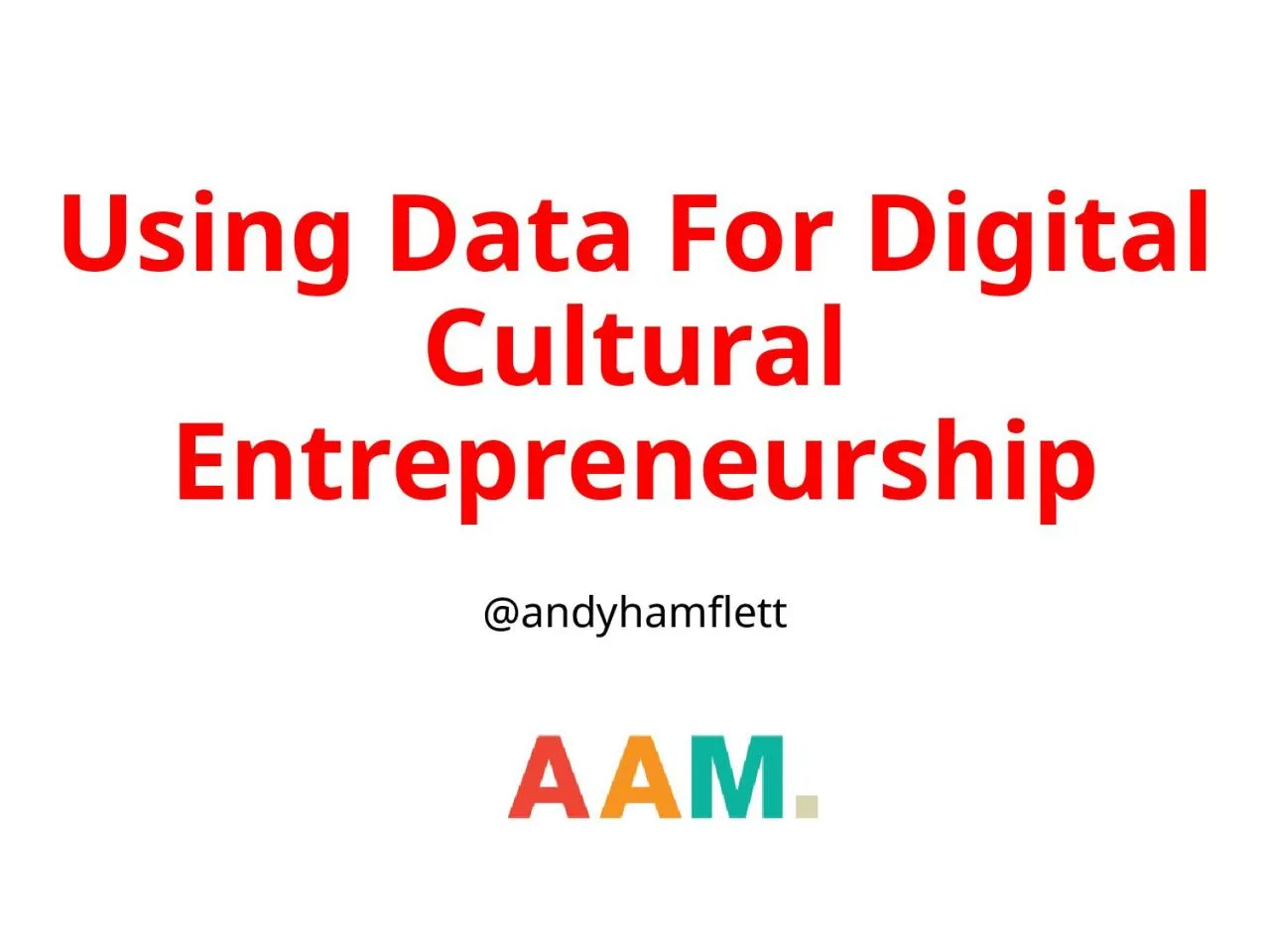

C ultural E ntrepreneurship andyhamflett WHY AM I HERE DATA BAD DATA BAD DATA BAD DATA MISUNDERSTOOD SESSION OUTLINE SESSION OUTLINE SESSION OUTLINE BIG DATA QUÉ AAMAssociates andyhamflett ID: 914182
Download Presentation The PPT/PDF document "Using Data F or D igital" is the property of its rightful owner. Permission is granted to download and print the materials on this web site for personal, non-commercial use only, and to display it on your personal computer provided you do not modify the materials and that you retain all copyright notices contained in the materials. By downloading content from our website, you accept the terms of this agreement.
Slide1
Using Data For Digital Cultural Entrepreneurship@andyhamflett
Slide2WHY AM I HERE?
Slide3DATA = BAD
Slide4DATA = BAD
Slide5DATA = BAD
Slide6DATA = MISUNDERSTOOD?
Slide7SESSION OUTLINE
Slide8SESSION OUTLINE
Slide9SESSION OUTLINE
Slide10BIG DATA – QUÉ?
@AAM_Associates @andyhamflett
Volume –
Velocity
– Variety
Linked to data science: from ‘fishing’ to
t
esting a hypothesis
New tools and capabilities – new ways of thinking
Patterns = the death of theory?
WHAT IS IT?
WHAT’S NEW ABOUT IT?
WHAT CAN IT DO?
SOME TERMS
Targeted
marketing:
Amazon / Facebook
Mothers-to-be
Summer sales
UPS road haulage
Open Data
Linked data
Slide11NEW WAYS OF SEEING
Slide12NEW WAYS OF SEEING
Slide13TREND ANALYSIS
Slide14CITIZEN SCIENCE
Slide15COMMUNITY UNDERSTANDING
Slide16REAL-TIME UNDERSTANDING
Slide17GEO-LOCATION
Slide18DRIVING INQUIRY
Slide19ADVANCED ANALYSIS
Slide20PREDICTIVE MODELLING
Slide21Definition of purposeData exploration and visualizationWhat data is available? What quality? What insights can we get from the current data?What further data is needed?Predictive model building
Data improvement
Collect and clean internal data
Combine with external and open data
Build predictive models that will support better decision-making
Understand the purpose and mission of the organisation.
Map the core activities that comprise the business model
Analytics driven business processes
Use models as the basis for action-taking
Collect evidence about what works (e.g., control trials)
Descriptive analytics
Predictive analytics
Prescriptive analytics
THE DATA JOURNEY
Slide22DESCRIPTIVE ANALYTICS
Slide23DESCRIPTIVE ANALYTICS
Slide24DESCRIPTIVE ANALYTICS
Slide25DATA VISUALISATION
Slide26DRIVING INQUIRY
Slide27DRIVING INQUIRY
Slide28DRIVING INQUIRY
Slide29PREDICTIVE MODELLING
Slide30LESSONS?
PURPOSE
SMALL IS BEAUTIFUL
NOT JUST NUMBERS
LINK
FIND PARTNERS
PERSIST
Slide31“All we know is who walks through the door. We don’t know who they are, what they’re doing or what they’re learning.”Maxwell L. Anderson, Director of the Dallas Museum of Art. BARRIERS IN THE ARTS
Slide32DMA FREE MEMBERSHIP
Slide33BARRIERS IN THE ARTS
SKILLS / EXPERTISE
ORG CULTURE
FUNDING
THE RIGHT QUESTIONS
PARTNERS
PERSIST
Slide34Q: How do you get started? Suggestions:Get buy-in from the top and find advocates lower down.Visualisation can be incredibly powerful in getting people excited, highlighting value and creating tangible appetite for more. It doesn’t necessarily have to be ‘Big’ data. Work with what you have. Link whatever data sources you have.It’s not just about numbers. Data platforms can work with text, images, geo-location, etc.CONVERSATION POINTS
Slide35Q: How do you find the resource? Suggestions:Use the ROI that others have found in other case studies.Seek third party funding, or there are organisations (AAM, the OR Society, Datakind) who can help you make connections to pro bono or paid-for resource. Q: What should you focus on? Suggestions:Start with a strong understanding of your organisational or business purpose, but don't be too limited. You want new eyes and new approaches to challenge you.Be prepared to think broadly and make changes to delivery.Look for partnerships. Your data becomes more powerful the more you share it (within certain safety boundaries, of course).CONVERSATION POINTS
Slide36www.aamassociates.comandy@aamassociates.com@AAM_Associates@andyhamflettWEBSITE:EMAIL: